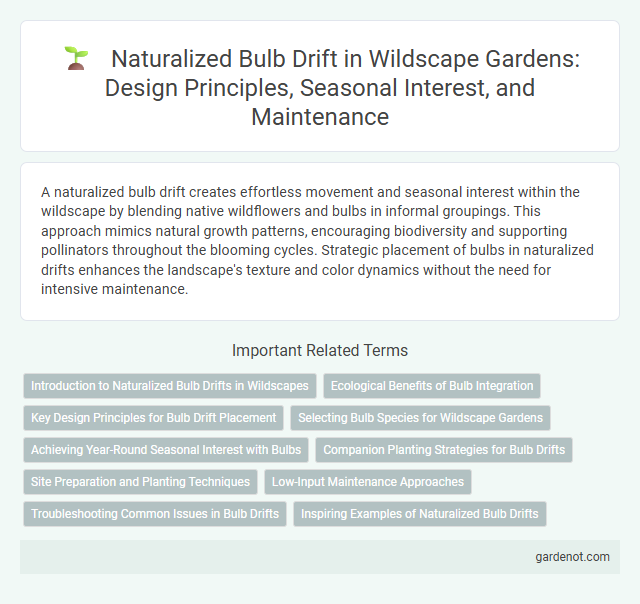A naturalized bulb drift creates effortless movement and seasonal interest within the wildscape by blending native wildflowers and bulbs in informal groupings. This approach mimics natural growth patterns, encouraging biodiversity and supporting pollinators throughout the blooming cycles. Strategic placement of bulbs in naturalized drifts enhances the landscape's texture and color dynamics without the need for intensive maintenance.
Introduction to Naturalized Bulb Drifts in Wildscapes
Naturalized bulb drifts in wildscapes create dynamic, self-sustaining ecosystems by allowing bulbs such as daffodils, crocuses, and bluebells to multiply and spread naturally across meadows and woodland edges. These bulb populations support pollinators like bees and butterflies by providing staggered bloom times and rich nectar sources throughout the growing season. Integrating native and naturalized bulbs enhances biodiversity, soil health, and visual appeal while minimizing maintenance in natural garden designs.
Ecological Benefits of Bulb Integration
Naturalized bulb drift supports biodiversity by providing continuous nectar sources for pollinators such as bees and butterflies throughout changing seasons. Integrating bulbs into wildscapes enhances soil health through natural nutrient cycling and reduces erosion by maintaining ground cover. This ecological strategy promotes habitat connectivity, supporting diverse wildlife populations and fostering resilient ecosystems.
Key Design Principles for Bulb Drift Placement
Naturalized bulb drift thrives by replicating natural growth patterns, emphasizing irregular groupings of 10 to 20 bulbs to avoid uniformity and enhance visual appeal. Placement near woodland edges or mixed perennial beds maximizes seasonal interest while ensuring bulbs receive appropriate sunlight and soil moisture conditions. Incorporating native species like daffodils, snowdrops, and crocuses supports local ecosystems and creates a dynamic, sustainable landscape design.
Selecting Bulb Species for Wildscape Gardens
Selecting bulb species for wildscape gardens centers on choosing naturalized bulbs that thrive in local climates and support native wildlife. Species such as daffodils (Narcissus spp.), snowdrops (Galanthus nivalis), and bluebells (Hyacinthoides non-scripta) are excellent for creating naturalized drifts due to their adaptability and early nectar supply for pollinators. These bulbs require minimal maintenance, multiply over time, and enhance biodiversity by providing seasonal color and habitat continuity.
Achieving Year-Round Seasonal Interest with Bulbs
Naturalized bulb drift creates continuous seasonal interest by planting a mix of early, mid, and late-blooming bulbs such as snowdrops, daffodils, and tulips. Achieving a naturalized effect involves scattering bulbs irregularly across lawns, woodlands, and meadows to mimic wildflower growth patterns. This technique supports biodiversity, extends blooming periods, and enhances landscapes with vibrant colors throughout the year.
Companion Planting Strategies for Bulb Drifts
Naturalized bulb drifts thrive with companion planting strategies that enhance soil health and extend bloom periods, such as pairing daffodils with early-spring ephemerals like Siberian squill. Integrating ground covers like creeping thyme or ivy helps suppress weeds and retain moisture, fostering optimal growth conditions for bulbs. Selecting plants with complementary flowering times and root depths maximizes garden aesthetics and promotes biodiversity within wildscape environments.
Site Preparation and Planting Techniques
Site preparation for naturalized bulb drift involves loosening soil to improve drainage and adding organic matter to enhance nutrient availability. Planting techniques include spacing bulbs in irregular clusters at varied depths to mimic natural growth patterns and encourage natural spreading. Ensuring bulbs are planted before the onset of frost promotes strong root development and successful establishment.
Low-Input Maintenance Approaches
Naturalized bulb drift in wildscapes promotes biodiversity while requiring low-input maintenance through natural seed dispersion and adaptive plant communities. These bulb drifts reduce the need for frequent watering, fertilization, and pest control by leveraging species that thrive in native soil and climate conditions. Utilizing drought-tolerant species like native daffodils and crocuses enhances landscape resilience and minimizes resource use.
Troubleshooting Common Issues in Bulb Drifts
Naturalized bulb drifts can face challenges such as poor flowering, bulb rot, and uneven growth due to improper soil drainage and inconsistent watering. Address soil quality by ensuring well-drained, sandy loam with organic matter to prevent waterlogging and fungal diseases. Regularly inspect bulbs for pests like bulb mites or fungal infections, and rotate planting locations every few years to reduce disease buildup and nutrient depletion.
Inspiring Examples of Naturalized Bulb Drifts
Naturalized bulb drifts transform landscapes by creating vibrant, self-sustaining displays that bloom year after year with minimal intervention. Iconic examples include the sweeping carpets of daffodils in New York's Central Park and the elegant tulip drifts at Keukenhof Gardens in the Netherlands, showcasing how naturalized bulbs enhance biodiversity and seasonal interest. These inspiring installations demonstrate the ecological benefits and aesthetic appeal of integrating bulbs such as crocuses, snowdrops, and alliums into naturalized garden settings.
Naturalized bulb drift Infographic

 gardenot.com
gardenot.com